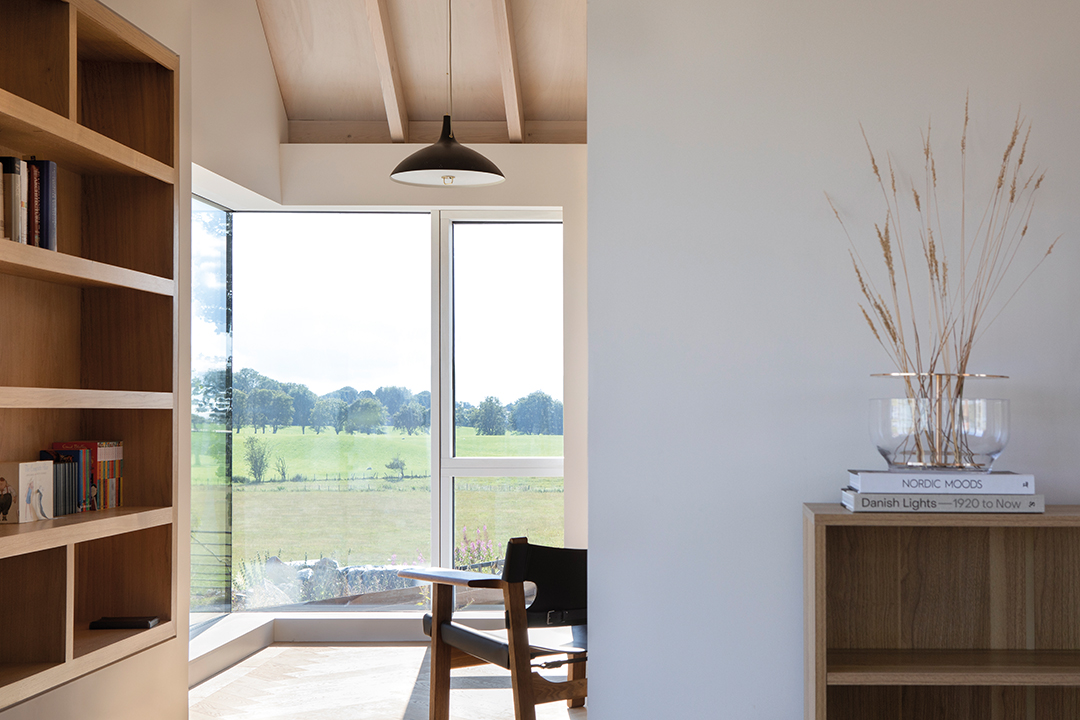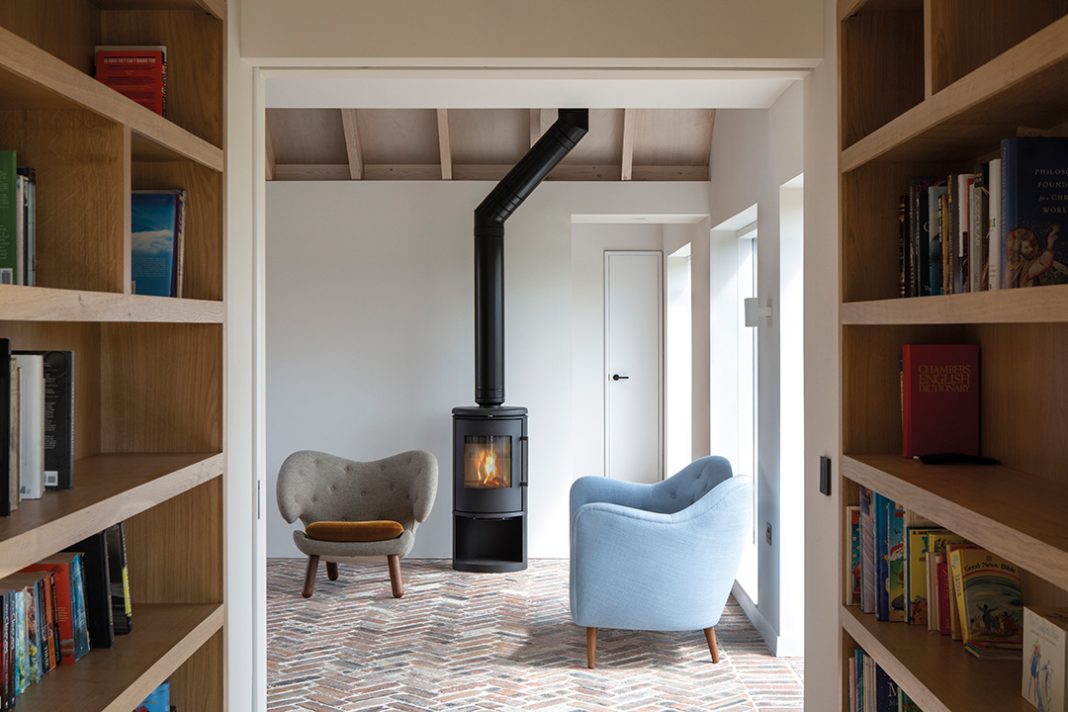A sense of connection to the land and its surroundings lies at the heart of this home on a South Lanarkshire farm
words Judy Diamond | photography Dapple
At first glance, this recently completed five-bedroom house in the fields of South Lanarkshire, named Ceangal House, seems understated to the point almost of invisibility.
The rusty-red aluminium exterior could be just another barn among the dozens that dot the farmland around here.
Inside, meanwhile, is pared back to the bone: no architraves, no skirtings, no window frames, no radiators and scarcely even a light switch. The stair handrail is the plainest you’ll ever see. But this is a house that rewards closer inspection.
Its shape, construction and materials all work together to produce something far more than the sum of its parts. It’s no surprise at all, in fact, to discover that it’s up for one of the most prestigious prizes in British architecture.
L-SHAPED LAYOUT
“I don’t think it stands out too much,” agrees Iain Monteith, one half of Loader Monteith, the Glasgow practice behind the South Lanarkshire project.
“You might wonder what it is as you drive past, if only because of the pitched roofs. It’s one of those buildings that you might not remember or even notice unless you took the time to really study it.
Then you might start appreciating the details and see it’s a wee bit different.”

The studio he set up with Matt Loader in 2016 had only been established for a year when the clients, James and Lorna, came to them and said the words all architects want to hear: “We’d like you to design something of architectural merit.”
The couple had a South Lanarkshire farm that had come to them through their family and were looking to use a corner of it to build a home for themselves and their young daughters.
Monteith went and took a look. “This was a proper farm, with sheep and cattle in the fields and other farmers working parcels of land,” he recalls.

BRITISH ARCHITECTURE
Among the barns and sheds there was a tumbledown steading – too small and too dilapidated for what James and Lorna had in mind, but with a wonderful southerly aspect. It would make the ideal site for a new house.
The L-shaped layout that Loader Monteith came up with made the most of those south-facing views. The public areas are contained in one leg of the L, under a trio of pitched roofs, clearly inspired by the agricultural forms of this rural stretch of South Lanarkshire.
The bedrooms are in the western leg. A self-contained office/studio stands on the eastern side, so that a sheltered courtyard is formed to the rear.
Along with accommodating the owners and their young family, the brief was to provide space for guests to stay and to ensure the house could adapt to multigenerational living if required.
Once again, the architects found the solution to this in their contemplation of the setting.

“The house expands and contracts,” explains Monteith. “As you approach, you’re coming from wide open space and landscape views, then you’re enclosed by trees, then you arrive and you’re in an open landscape again.
“So we designed the house so you enter via the boot room/lobby, a dark little chamber that opens out into the first and smallest volume, the kitchen-dining space, and then you move through the building with the ceilings getting higher.”
SUSTAINABLE CONSTRUCTION
At the corner of the L, under the largest pitched roof, is the reading room and the stairs leading up to the guest bedroom.
“The clients said they wanted the option of coming together as a family or being able to retreat and be alone, so the reading room can be closed down or opened up to the rest of the house with sliding doors. This concept of expansion and contraction runs all the way through it.”
When relatives or friends come to stay, the reading room is closed off for them, giving them their own little living room as well as the upstairs bedroom.
“James and Lorna were quite surprised when we showed them our ideas for the first time,” reflects Monteith. “I don’t think it was what they were expecting. But they were very pleased when they realised what kind of spaces it would afford the family.
James was very good at interrogating the design – why are we doing this? What is that bit for? It was great – it made us reflect on what we were doing.”
Discussions followed about materials and sustainability, and about the possibility of reclaiming the stone from the now-demolished steading.
Turning the reality, though, was a real labour of love.

“Reclaiming materials sounds great but you can’t do it without the client’s support or, in this case, without the client’s hard work,” acknowledges Monteith.
“James had to go through huge piles of rubble. He collected all the bricks that we’ve used for the floor – more than 4,000 of them. It was all driven by him. Can you imagine a project where you’re having to convince a client to do that?”
As well as the bricks, sandstone from the old steading walls has been repurposed as the lower portion of the new façade. And while the bricks bring colour and character to the interior, their purpose is not merely decorative.
With the house oriented to achieve as much solar gain as possible, the floor acts like a giant storage heater, absorbing the warmth from the sun during the day and then releasing it in the evening.
Triple-glazed windows, a super-insulated roof and an air-source heat pump (there is underfloor heating too) are just some of the ways the couple invested in making their home as low-energy as possible.

RECLAIMED BUILDING MATERIALS
You can cut costs by reclaiming materials, of course, but any money saved here was ploughed back into paying for labour – reassembling the bricks and sandstone took a lot of time and skill.
“I’d say the envelope is basic, apart from the windows,” says the architect of where the budget was spent. “The clients chose to invest in environmentally high-performing windows with slim frames and glass-to-glass junctions.
The agricultural cladding is not a luxury, it’s not like zinc. And they were keen to keep the materials in the interior as ‘honest’ as possible.”
To that end, while the stairs and the floor in the bedroom wing are oak, the owners went for unveneered ply and pine rafters for the ceilings rather than a more expensive wood. As Monteith points out, it had to have fire-coating because it’s a timber ceiling, so why use the likes of expensive Douglas fir?
Painstaking efforts were made to find a tint of fire-coating that would allow the pine and the ply to perfectly match the kitchen that the owners had commissioned from Archispek.
“The last thing any of us wanted was to have four or five different colours or types of timber all clashing and competing for attention.”

Where they did spend was on the aforementioned kitchen and the tech. The latter included a Lutron system to control the lighting along with the heating, ventilation, security and audio-visual services, all controlled by a phone or touch-screen (hence the lack of visual clutter such as light switches).
Future-proofing their home, making it durable and sustainable and economic to run will all pay off in the long term.
“It looks a bit different since these photos were taken,” says Monteith. “I was back in South Lanarkshire recently, showing it to the judges of the Manser Medal, and we were discussing volumes and materials, and I was thinking that it’s now so clear that this is a family home.
“James and Lorna and the kids have moved in and they’ve brought their furniture, their books, their art, their toys. The corridor leading to the bedrooms was plastered with kids’ drawings – it was lovely. And that’s really what it’s all about.
“You as an architect can’t control it. You can’t be too precious. You’ve got to hand it over. In any case, it’s much richer once people inhabit it.”






